The Gift of South Dakota
Subscriptions to South Dakota Magazine make great gifts!
Subscribe today — 1 year (6 issues) is just $29!
On Target
Editor’s Note: The NFAA Easton Yankton Archery Complex and the city of Yankton are preparing to host hundreds of archers ages 15 to 20 and their families at this summer’s Youth Archery World Championships June 6-15. Over 500 competitors from 60 countries will spend time exploring the city and perhaps the rest of southeastern South Dakota. The Yankton complex has already hosted several state and national tournaments, drawing thousands of visitors for whom Yankton was simply a dot on a map. Its experts have also trained Olympians. But how did it happen? This story from our March/April 2011 issue explains how Yankton took a shot at becoming an archery mecca — and hit the bull’s-eye.
He’s a soft-spoken, unassuming, down to earth, blue collar guy from Tyndall, South Dakota — definitely not the sort of man you’d think would be given to pipe dreams. So when Jon Straub talks about aiming at a spot on the U.S. Olympic archery team you can’t help but take him seriously.
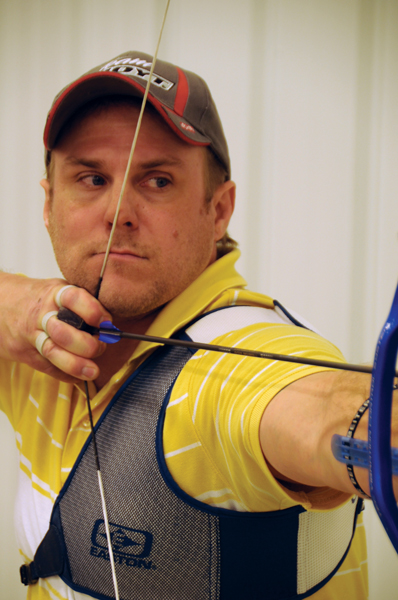 |
| Jon Straub of Tyndall trained for a spot on the U.S. Olympic archery team at the NFAA Easton Yankton Archery Complex, just 30 miles away from his home. |
This isn’t some passing notion, either. “My dad got me started hunting when I was pretty young, but nobody in my family bow hunted or even shot a bow,” Straub says. “Then I happened to catch an old Fred Bear film. He’s the godfather of bow hunting, and I thought, I want to do that. So I saved up and bought a bow. I shot it every day. Chased rabbits and squirrels and whatever. I’m surprised I didn’t wear it out.
“I still do some hunting with a gun, but I’d rather bow hunt. It’s more fun, and more of a challenge.” Even bow hunting has taken a back seat to Straub’s new passion, however. “I’m always in a hurry to fill my deer tag so I can get back to target shooting. I wasn’t quite as picky this year as in the past, but I still got a pretty nice five by five.”
There wasn’t much information on target archery when he started out, but the bits and pieces he came across were enough to kindle Straub’s interest. A buddy introduced him to 3-D shooting, a competition where archers shoot at life-sized figures of various animals. “I went with him and shot a few tournaments,” he says. “That was fun, but target shooting was the direction I wanted to go. I just never lived in a place where it was possible.”
That changed for Straub in 2007, thanks in no small measure to the efforts of Bruce Cull, the co-owner of Dakota Archery & Outdoor Sports in Yankton. Cull, who had long been active in the National Field Archery Association (NFAA), was elected president of the organization in 2002. The NFAA had been discussing ways to expand its operations, but was constrained by the limitations of its headquarters in Redland, Calif. Cull was in the right place at the right time to suggest South Dakota as an alternative.
At the same time, the Easton Sports Development Foundation (ESDF) was looking to establish regional centers across the country to teach and promote all aspects of archery. They came to appreciate the idea of setting up shop in conjunction with the NFAA.
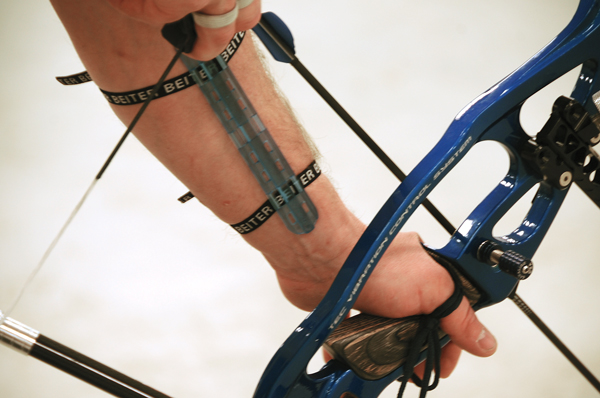 |
| Straub, who shoots daily, is able to practice for hours at a time thanks to a strap on the inside of his forearm and leather protection for his fingers. |
“Bruce is a master at getting people together and organizing things,” says Ken Buhl, manager of the NFAA/ESDF facility. With Cull on point and the backing of the local business community, the city and county of Yankton came together and donated a 39-acre parcel of land on Yankton’s east side. Ground was broken in April 2007, and by that fall a 20,000 square foot structure at 800 Archery Lane was open for business. In addition to the NFAA and ESDF offices, the building houses an indoor, 20-meter shooting range and archery museum.
Elsewhere on the property are four 3-D and field courses, and a covered shooting area that opens onto a 90-meter range. The only equivalent facilities in the United States are at the Olympic training center in San Diego. There is a KOA campground adjacent to the complex, and space has been earmarked for the future placement of baseball and soccer fields.
“It was a real blessing for me when they opened this place,” says Straub with a wide grin. “I ran right down here and talked to M.J. It was awesome.”
“M.J.” is M.J. Rogers, the facility’s resident coach, and Straub was indeed fortunate to connect with him. Rogers has been coaching archers for 20 years, including five spent at the U.S. Olympic training center. He coached a Canadian archer at the 2004 games in Athens, and is currently coaching four individuals getting ready for the 2012 trials.
Virtually every Olympic-style target shooter started out as a bow-hunter, says Rogers, but from a coach’s perspective, the transition between the two isn’t necessarily smooth. Bow hunting is often a solitary activity, with long hours spent lying in wait for game; that cultivates an independent frame of mind, which can make those individuals somewhat resistant to coaching. “That’s just the nature of the beast,” Rogers says.
That has never been a problem for Straub. “Whatever M.J. tells me to do, I do it,” he says. “I know where I want to be eventually, and he can help get me there. Everything I ever learned in the past, I had to throw that out the window. This is a totally different style of shooting. It’s a process unto its own. You have to be willing to start from scratch.”
Olympic archers use recurve, rather than compound bows in competition. (World class recurve bows are high tech devices in their own right, with precision machined aluminum handles and carbon fiber arms, but they don’t have the distinctive pulleys and optical sights of compound bows.) Competition arrows are pencil thin aluminum shafts wrapped in carbon fiber, and like the bows, they are not cheap: a dozen will cost in the neighborhood of $400.
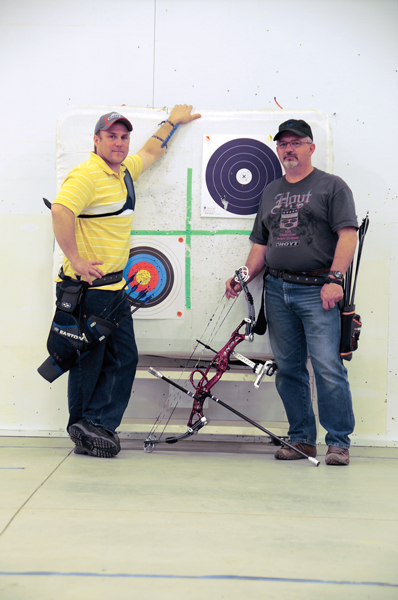 |
| Straub (left) and Keith Hofer have found a home away from home at Yankton's archery center. Hofer competes in regional tournaments with a compound bow (shown), while Straub hones his skill with the recurve bow used in the Olympics. |
Olympic events are always held outdoors, regardless of weather conditions; the wind especially can raise havoc with competitors’ accuracy, but unless there’s lightning bolts in the sky events are never cancelled. They shoot at a distance of 70 meters (about 77 yards) at a bull’s eye 12 cm (4.75 inches) in diameter. World-class archers will average four of six arrows in that circle all the time, and unless the conditions are terrible, never miss the outer ring, which is twice that size.
It takes seven to 10 years to develop an Olympic-level archer, according to Rogers, and they must commit to training five to six days a week, four hours a day. “Physical attributes are important to a degree, but not nearly as important as mental conditioning,” he says. “Shooting an arrow is similar to a golf swing in that there’s fluidity to the movement. The more fluid that movement, the less you try to control it, the more successful you’ll be. Success comes from not trying, and that’s a very difficult component of the sport.”
Straub has embraced that training discipline wholeheartedly. “Outside of work, archery is all I do anymore,” says Straub. “I hunt a little bit, but it’s mostly archery. My whole life revolves around shooting bows in one form or another. It’s all I want to do. I never get tired of shooting every day. I wish I could shoot more.”
When he can’t get to Yankton to use the indoor range Straub shoots at a bale, with no target, “strictly to work on the feeling of the shot, on perfecting my form. Or if I’m just sitting around I’ll use a piece of rubber surgical tubing. I close my eyes and stretch it back, just to get the feel of the shot. Ideally you want to be a shooting machine, every shot the same as the last.”
Olympic archery competitions, “are raucous events, more like a basketball game than a golf match,” according to Rogers. “They hand out noisemakers, there’s cheering. It’s very noisy.” That puts a premium on discipline and the ability to focus, and those can only be developed from tournament experience.
“This year is a developmental year. I still have a lot of work to do before I’m at what I consider the upper level,” Straub says. “If M.J. thinks I’m ready I’ll get on the 70-meter range this summer. I can’t wait to compete at that range. I shot some on it last year, but I’ve come a long way since then, so I’m anxious to get out there. I’ve had a lot of coaching sessions with M.J. He’s made it all possible. If it weren’t for him I wouldn’t be thinking of the Olympics.”
Does this soft-spoken, unassuming, down to earth, blue-collar guy from Tyndall, South Dakota really think he can get there? “I don’t know many people as determined as me,” Straub says quietly. “I’ve finally got the chance to live out my dream, and I intend to make it come true.”


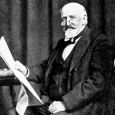

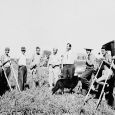

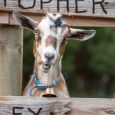
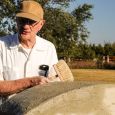


Comments